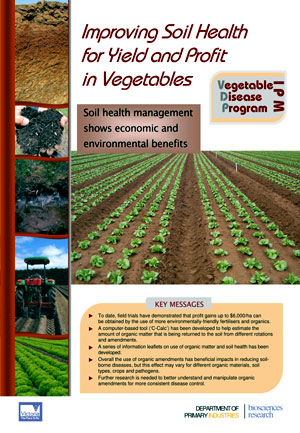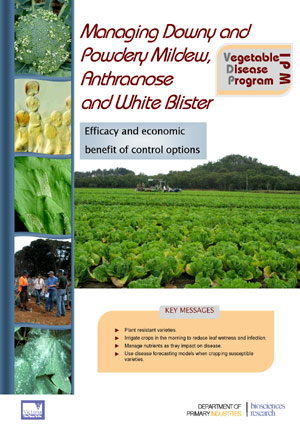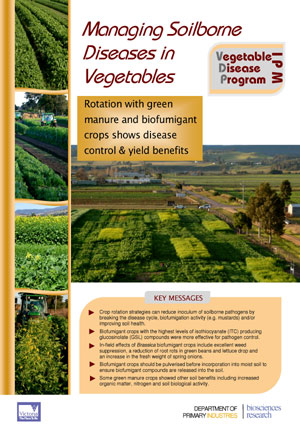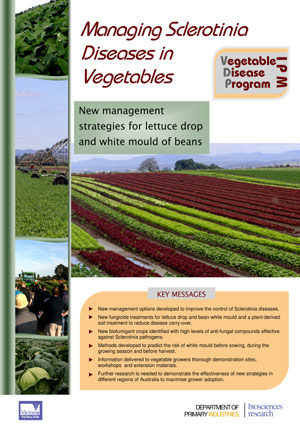|
Summaries
and key outcomes of four vegetable research projects aimed at managing a range of Foliar and Soilborne diseases of vegetable crops
and improving soil health.
These summaries aim to :
- Inform the vegetable
industry of new options developed for
managing vegetable diseases and soil
health
- Provide an understanding of
how these options can be integrated into a strategy
for sustainable vegetable production.
VG07008 ‘Improving Soil Health
for Yield and Profit
in Vegetables’
Soil health management
shows economic and
environmental benefits


Researchers at the Victorian Department of Primary Industries are finding that a range of
different soil health practices have both environmental and economic benefits to growers.
By measuring biological, physical and chemical properties in soil they are identifying which
methods improve soil quality, whilst providing good yields and maximum profit.
KEY MESSAGES
- Measuring & Monitoring Soil Health
- Economic Benefits of Soil Health
- Effect of Soil Carbon on Disease
- ‘C-Calc’ – calculates Organic Matter
added to soil
- Soil Health Management Guide
VGO7070 ‘Managing Downy and
Powdery Mildew,
Anthracnose
and White Blister’
Efficacy and economic
benefit of control options


KEY MESSAGES
- Plant resistant varieties.
- Irrigate crops in the morning to reduce leaf wetness and infection.
- Manage nutrients as they impact on disease.
- Use disease forecasting models when cropping susceptible
varieties.
ECONOMICS
- Growing a white blister resistant broccoli variety increases profits by 22%.
- Irrigating at 4 am rather than 8 pm, increases profits by 5%.
- The Brassicaspot models for white blister can increase profits by 25%, especially on white blister
susceptible varieties.
- The BremCast model for downy mildew on lettuce is as good as, or better than, Farm Best Practice
or Weekly sprays for contribution to farm profit.
It can achieve a 6% increase in profit.
VG07070 – Summary – September 2010
Includes:
- Resistance to Downy Mildew and Anthracnose in Lettuce
- Resistance to White Blister
- Managing White Blister with variety selection and irrigation timing
- Disease predictive models BrassicaSpot, DownCast & BremCast
- In-field Spore Test Kit for White Blister
- Fungicide alternatives
- Effect of Nitrogen fertilisers on Lettuce Downy Mildew and Anthracnose
- Economics of control options
VG07125 ‘Managing Soilborne
Diseases in
Vegetables’.
Rotation with green
manure and biofumigant
crops
shows disease
control & yield benefits


Researchers at Vic DPI, Qld DEEDI and Peracto are finding that green manures and Brassica
biofumigant crops provide many benefits within vegetable cropping systems.
Information from
trials including the agronomic characteristics of these crops, their biofumigant potential, effects on
key soil health parameters and compatibility with current cropping systems is being used to
develop new strategies for managing soil-borne diseases in vegetable production.
KEY MESSAGES
VG07126 ‘Managing Sclerotinia
Diseases in
Vegetables’
New management
strategies for lettuce drop
and white mould of beans


Researchers at DPI Vic, Peracto Pty Ltd, TIAR/UTAS and Qld DEEDI have worked together to
investigate and develop multiple management options for Sclerotinia, using lettuce and green
bean as model crops,
The long term aim of this research is to identify effective control measures and beneficial cultural
practices for managing Sclerotinia which can be integrated into IPM and Best Management Practice
(BMP) programs for sustainable production of vegetables in Australia.
KEY MESSAGES
Acknowledgments
This publication covers research conducted as part of Horticulture Australia’s IPM Vegetable Disease and soil health programs.
The following organisations and people are gratefully acknowledged for their contribution to this research: grower
collaborators and consultants, in Victoria, Tasmania and Queensland and many researchers and support staff.
VG07125 ‘Best-practice IPM strategies for control of major soilborne diseases of vegetable crops’
Caroline Donald, Cassie Scoble, Ian J Porter, Scott Mattner, Ross Mann, Oscar Villalta, David Riches, Denise Wite (DPI,
Victoria), Cherie Gambley (Agri-Science Queensland, DEEDI), Barry Condè and Mark Traynor (NTDR), Len Tesoriero and
Leanne Forsyth (NSW I&I), Alicia Greenhill and Kim Plummer (La Trobe University).
VG07126 ‘Integrated Management of Soilborne Pathogens – Sclerotinia’
Oscar Villalta, Denise Wite, Caroline Donald, Cassie Scoble, David Riches, Ian J Porter (DPI, Victoria).
Frank Hay and Suzie Jones (TIAR/UTAS Tasmania), Hoong Pung and Susan Cross (Peracto Pty Ltd, Tasmania), John Duff
(Agri-Science Queensland DEEDI).
VG07070 ‘Benchmarking predictive models, nutrients and irrigation for management of Downy, Powdery Mildews and White
Blister’
Elizabeth Minchinton, Joanna Petkowski, Desmond Auer (DPI, Victoria). Dr Victor Galea and Zaiton Sapak, The University of
Queensland. Dr Alison Wakeham and Dr Roy Kennedy of Warwick HRI UK. Lindsay Trapnel. Dr Belinda Rawnsley, Barbara
Hall and Lee Bartlett of SARDI Dr Chrys Akem and Dr Gerry MacManus of AgriScience DEEDI Queensland.
VG07008 ‘Benchmarking soil health for improved crop health, quality and yields in the temperate Australian vegetable
industries’.
Ian J. Porter, Scott Mattner, Robyn Brett, Belen Guijarro, Jacky Edwards (DPI, Victoria). Nick O’Halloran, Peter Fisher, and
Siggy Engleitner.
  

HAL projects are funded by the National Vegetable Research and Development Levy in partnership with AUSVEG and participating state government departments and other organisations.
The Australian Government provides matched funding for all HAL’s R&D activities.
|




